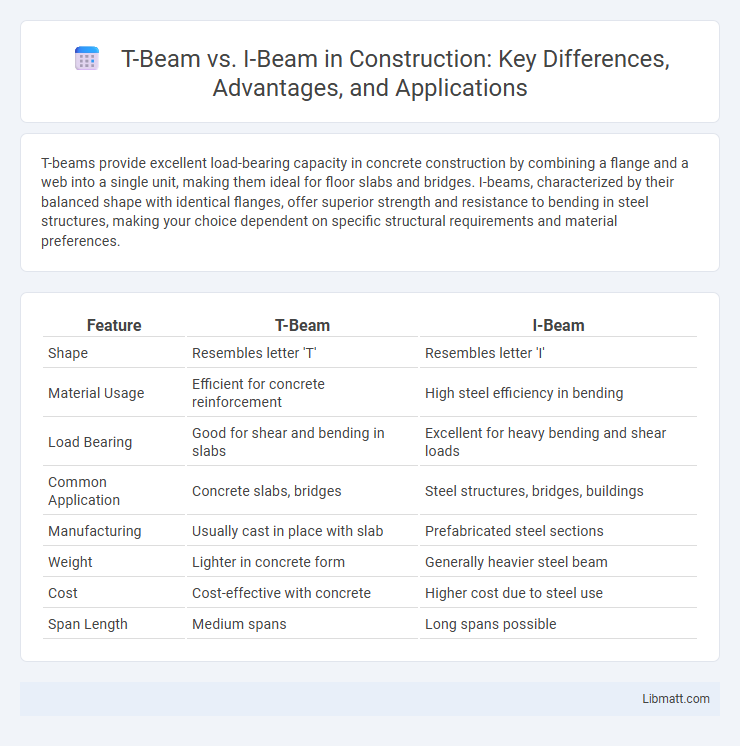T-beams provide excellent load-bearing capacity in concrete construction by combining a flange and a web into a single unit, making them ideal for floor slabs and bridges. I-beams, characterized by their balanced shape with identical flanges, offer superior strength and resistance to bending in steel structures, making your choice dependent on specific structural requirements and material preferences.
Table of Comparison
| Feature | T-Beam | I-Beam |
|---|---|---|
| Shape | Resembles letter 'T' | Resembles letter 'I' |
| Material Usage | Efficient for concrete reinforcement | High steel efficiency in bending |
| Load Bearing | Good for shear and bending in slabs | Excellent for heavy bending and shear loads |
| Common Application | Concrete slabs, bridges | Steel structures, bridges, buildings |
| Manufacturing | Usually cast in place with slab | Prefabricated steel sections |
| Weight | Lighter in concrete form | Generally heavier steel beam |
| Cost | Cost-effective with concrete | Higher cost due to steel use |
| Span Length | Medium spans | Long spans possible |
Introduction to Beam Structures
T-beam and I-beam are structural elements commonly used in construction to support loads and provide stability. The T-beam features a flange forming a "T" shape ideal for resisting bending in one direction, while the I-beam has a symmetrical "I" shape providing high strength-to-weight ratio and resistance to bending and shear forces in multiple directions. Your choice between these beams depends on the specific load requirements and structural design goals of the project.
What is a T-Beam?
A T-beam is a load-bearing structure with a horizontal top flange connected to a vertical web, resembling the shape of the letter "T." It combines the compressive strength of the flange with the shear resistance of the web, making it ideal for reinforced concrete construction in bridges and buildings. T-beams are commonly used in floor systems to carry bending and shear loads efficiently while reducing material usage.
What is an I-Beam?
An I-beam, also known as an H-beam or W-beam, is a structural steel beam characterized by its I-shaped cross-section, consisting of two horizontal flanges connected by a vertical web. This design provides high strength-to-weight ratio, making I-beams ideal for supporting heavy loads in construction projects such as bridges, buildings, and frameworks. The I-beam's geometry efficiently resists bending forces, offering superior load-bearing capacity compared to other beam types.
Structural Design Differences
T-beams feature a flange on top and a vertical web, providing enhanced load distribution and resistance to bending primarily in one direction, making them ideal for floor systems. I-beams have both top and bottom flanges connected by a vertical web, offering superior structural stability and strength in multiple loading conditions due to their symmetrical shape. Your choice between T-beam and I-beam should consider these design differences relative to the specific structural demands of your project.
Material Usage and Cost Efficiency
T-beams generally use less material than I-beams due to their integrated web and flange design, which reduces weight and manufacturing costs. I-beams, while often stronger in bending, require more steel, leading to higher material expenses and increased transportation costs. Choosing T-beams can optimize cost efficiency in projects where moderate load-bearing capacity is sufficient, minimizing steel usage and overall expenditure.
Load-Bearing Capacities
T-beams offer superior load-bearing capacities in bending and shear due to their flange and web configuration, effectively distributing weight over a larger area. I-beams provide excellent resistance to bending moments with a high moment of inertia but may be less effective than T-beams for resisting shear forces over wide spans. Your structural choice depends on the specific load distribution and design requirements of your project.
Applications in Construction
T-beams are commonly used in reinforced concrete floors and bridges where they provide excellent load distribution and resist bending efficiently. I-beams are preferred in steel construction for structural frameworks, supporting heavy loads in buildings, warehouses, and industrial projects due to their high strength-to-weight ratio. Your choice between T-beam and I-beam depends on specific project requirements like material type, load conditions, and construction methods.
Advantages of T-Beams
T-beams offer superior load distribution due to their wide flange, which increases bending resistance and reduces deflection, making them ideal for floor and bridge construction. Their monolithic structure combines the slab and beam, simplifying reinforcement and formwork, ultimately lowering construction costs and time. You benefit from enhanced structural efficiency and material savings when using T-beams in your building projects.
Advantages of I-Beams
I-beams offer superior strength-to-weight ratio, making them ideal for load-bearing applications in construction and engineering projects. Their design efficiently distributes weight along the horizontal axis, providing enhanced resistance to bending and shear forces compared to T-beams. Choosing I-beams can optimize material use while ensuring structural stability, benefiting your building's durability and cost-efficiency.
Choosing the Right Beam for Your Project
Selecting the right beam for a construction project depends on load requirements and structural design. T-beams provide enhanced moment resistance and are ideal for reinforced concrete slabs, offering efficient load distribution. I-beams, made of steel, excel in supporting heavy loads with minimal material, making them suitable for long spans and high-stress applications.
T-beam vs I-beam Infographic

 libmatt.com
libmatt.com